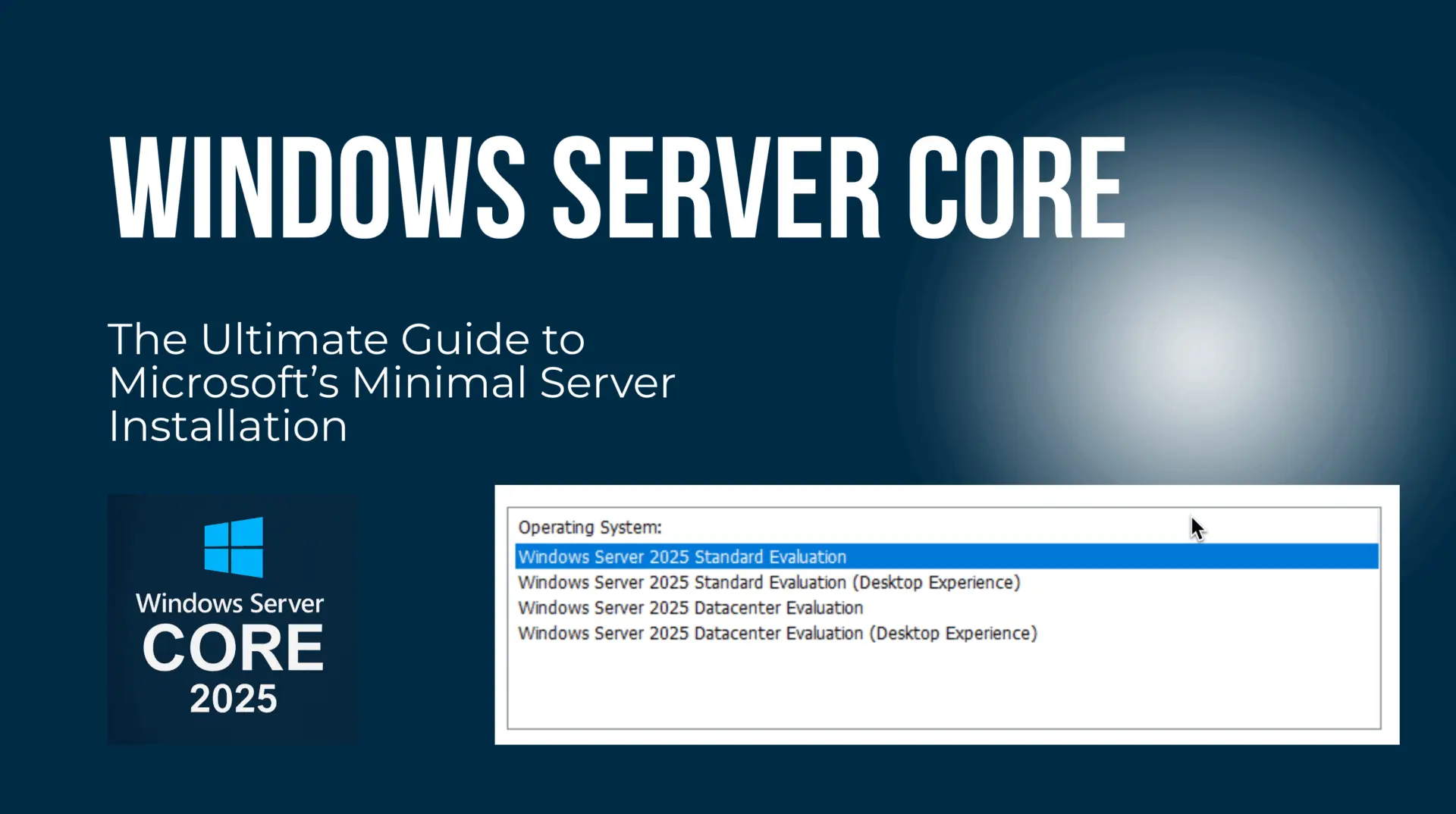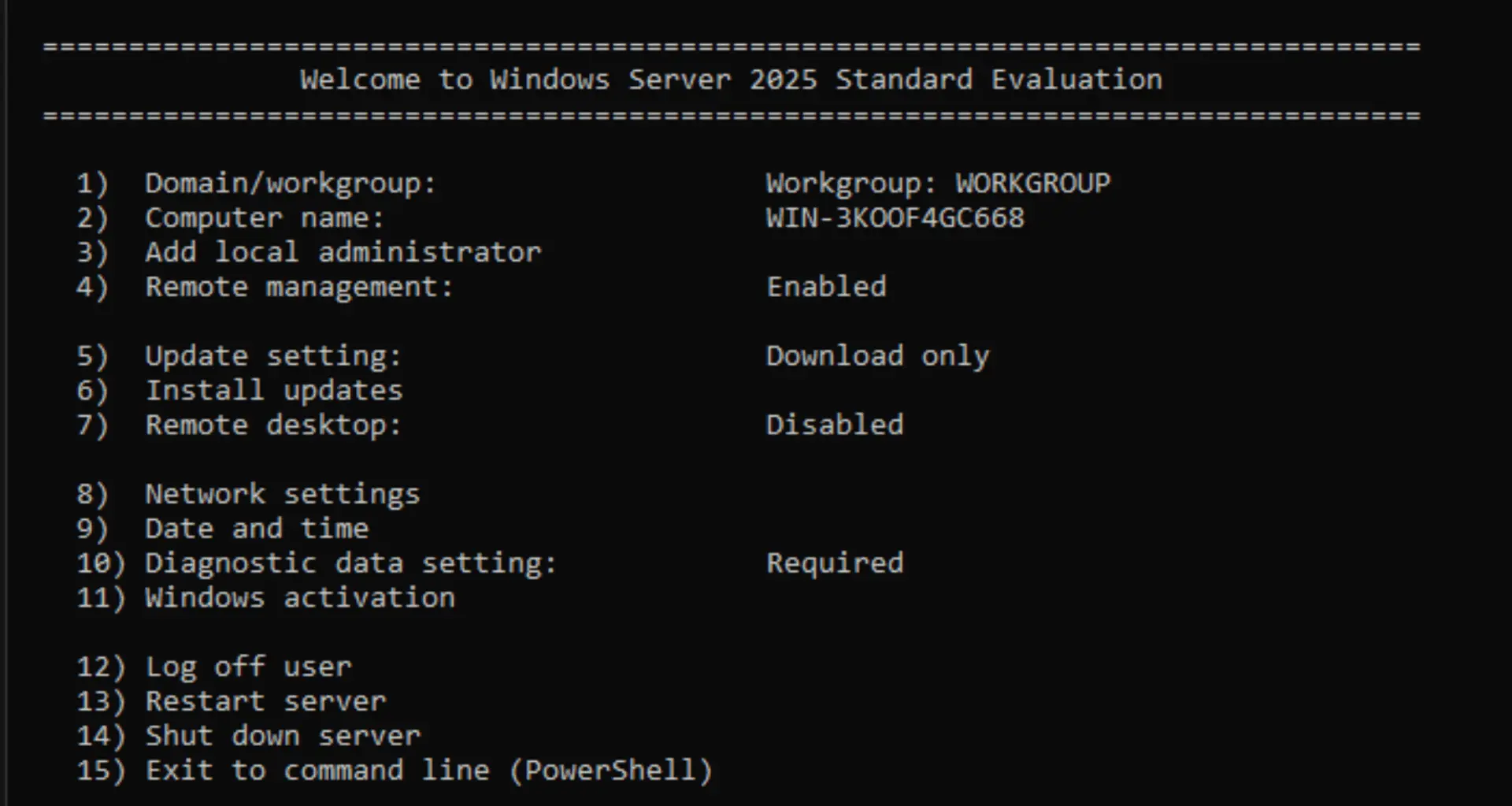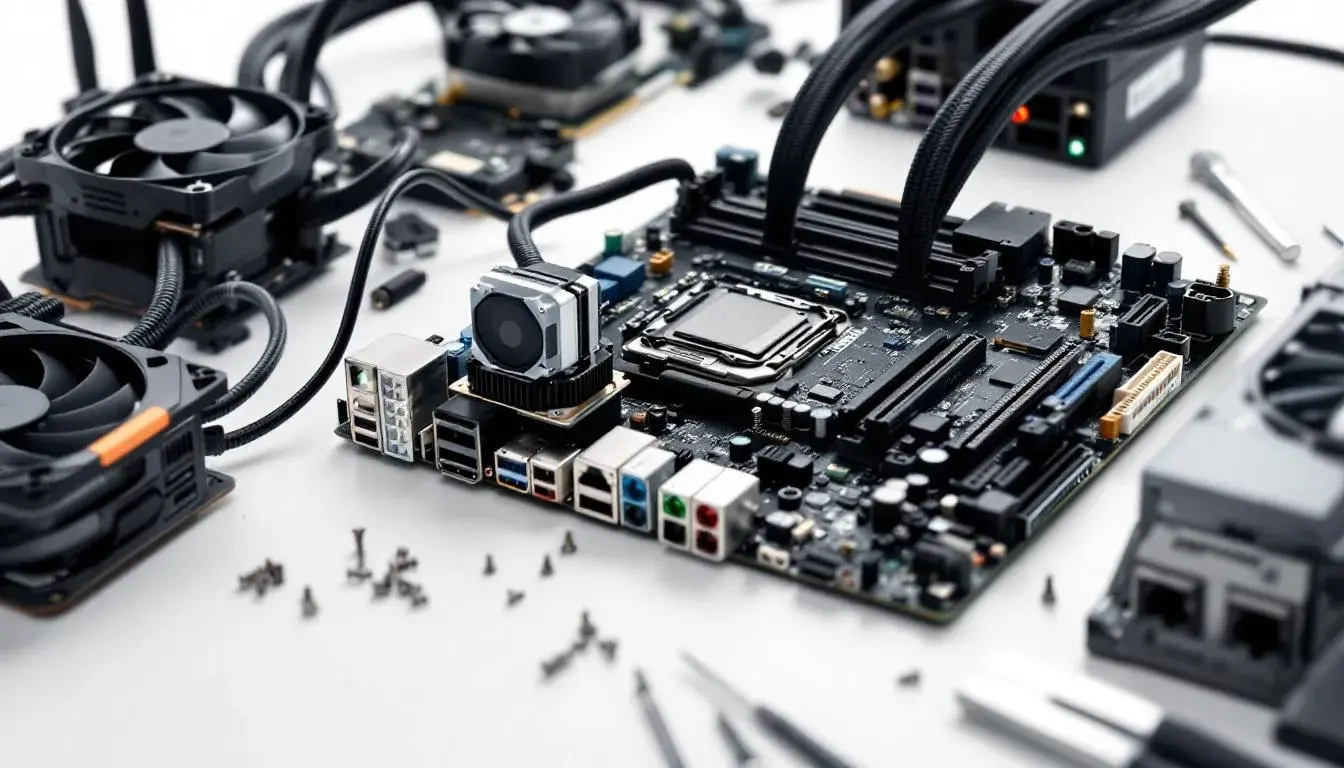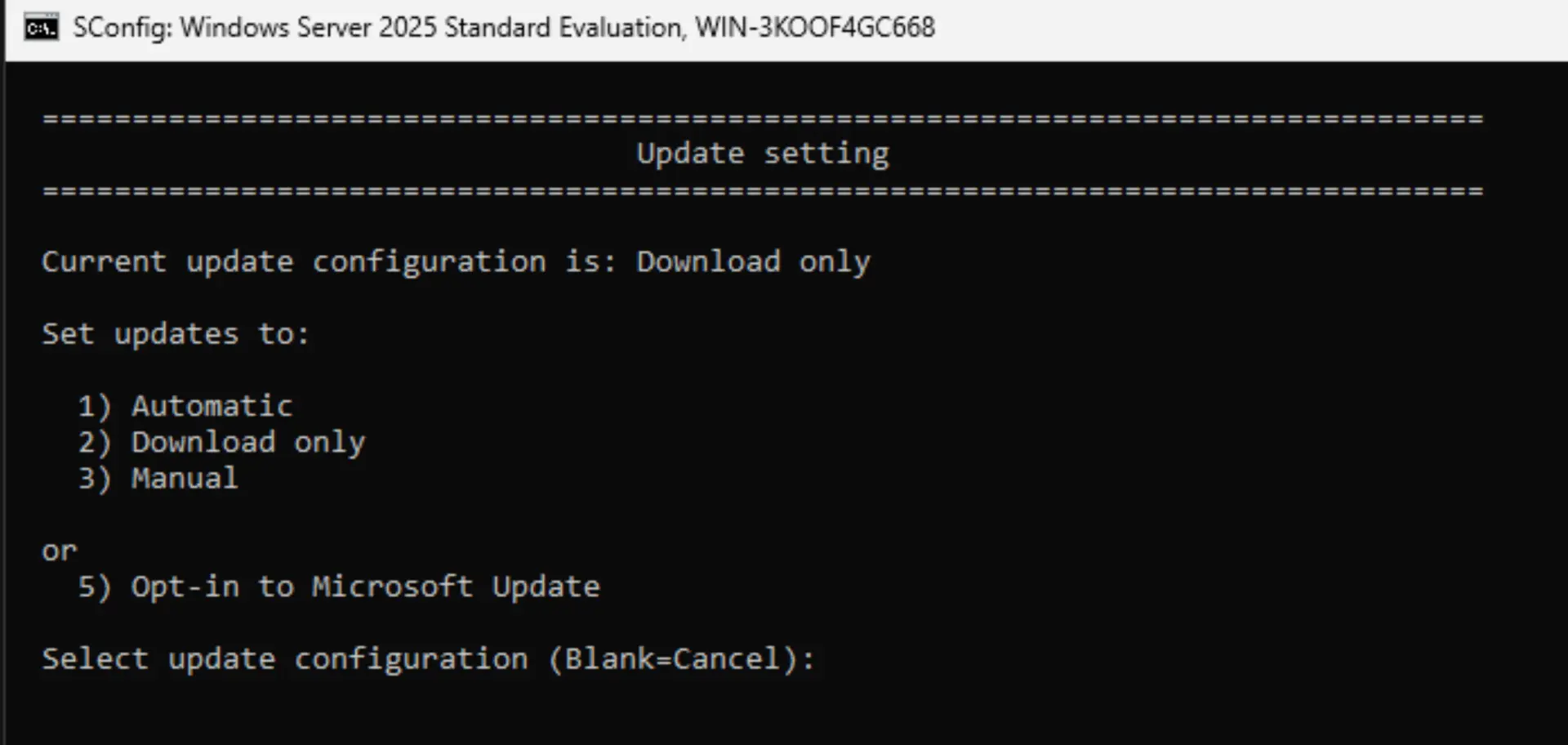By Edy Werder — IT Consultant & Tech Blogger
In today’s cloud-first world, every megabyte of disk space and every potential security vulnerability matters. What if you could reduce your server’s attack surface by up to 70% while cutting resource usage in half? Microsoft’s Windows Server Core makes this possible by stripping away the graphical user interface and non-essential components, leaving only what’s needed for critical server workloads.
Since its introduction in Windows Server 2008, Windows Server Core has evolved from a specialized deployment option to the preferred choice for modern data centers, cloud environments, and security-conscious organizations. This minimal installation option delivers enhanced performance, improved security, and reduced maintenance overhead compared to traditional Desktop Experience installations.

Key Takeaways
- Windows Server Core is a minimal installation option that reduces disk footprint by up to 60% compared to Desktop Experience
- Provides enhanced security with a smaller attack surface by removing GUI components and non-essential services
- Available since Windows Server 2008, and became the default installation option in Windows Server 2019
- Managed through PowerShell, command line, Windows Admin Center, and remote administration tools
- Supports most server roles, including Hyper-V, Active Directory, DNS, DHCP, and IIS
- Cannot switch between Server Core and Desktop Experience in Windows Server 2016 and later versions
What is Windows Server Core
Windows Server Core represents Microsoft’s vision for efficient server computing. This minimal installation option removes the graphical user interface and Windows Explorer shell, creating a command-line focused environment that prioritizes functionality over visual convenience. Unlike traditional Windows installations, Server Core includes only the essential services and subsystems required for core server workloads.

The most compelling advantage of the server core option lies in its dramatically reduced footprint. A typical core installation requires approximately 3.4GB of disk space, representing up to 60% less storage compared to Desktop Experience installations. This reduction extends beyond mere disk space – memory consumption, CPU utilization, and network overhead all decrease substantially when unnecessary GUI components are absent.
The smaller attack surface provides significant security benefits. Microsoft’s analysis revealed that approximately 70% of Windows Server vulnerabilities from 2002-2007 would not have affected Server Core systems. With fewer services running and less code executing, there are simply fewer vectors for potential exploits. This security advantage has made server core installations the preferred choice for domain controllers, edge servers, and other security-critical infrastructure components.
Performance improvements manifest in multiple areas. Boot times decrease noticeably without GUI initialization overhead. Windows updates install faster and require fewer reboots since many patches target graphical subsystems absent in Core. Under heavy workloads, systems demonstrate more predictable performance characteristics without background GUI processes competing for resources.
The core version excels in virtualized and cloud environments where resource efficiency directly translates to cost savings. Container workloads particularly benefit from the reduced overhead, as the Windows container base image built on Server Core provides a lightweight foundation for Windows-based containers.
Server Core vs Desktop Experience
Understanding the fundamental differences between server core installations and Desktop Experience helps inform deployment decisions. These variations extend beyond simple presence or absence of a GUI, affecting everything from management approaches to supported applications.
Feature | Server Core | Desktop Experience |
|---|---|---|
Disk Space | ~3.4GB | ~9-12GB |
Memory Usage | Lower baseline consumption | Higher due to GUI services |
Attack Surface | Minimal (fewer services) | Larger (full GUI stack) |
Management | Command line, PowerShell, remote tools | GUI consoles, MMC snap-ins |
Boot Time | Faster | Slower due to GUI initialization |
Update Frequency | Fewer updates needed | More frequent GUI-related patches |
Remote Desktop | RDP for administration only | Full desktop experience |
The management approach represents the most significant operational difference. Server Core requires administrators to embrace command line tools, windows powershell, and remote management consoles. While this presents a learning curve for GUI-accustomed administrators, it ultimately enables more scalable and automated management practices.
Desktop Experience installations support all Windows features and applications, including those requiring extensive GUI integration. However, this compatibility comes at the cost of increased resource consumption and expanded attack surface. Organizations must weigh these trade-offs against their specific application requirements and security policies.
Cost considerations favor Server Core in several scenarios. Virtual machine density increases when each instance consumes fewer resources. Licensing costs remain identical between installation types, but hardware efficiency improvements can reduce overall infrastructure spending. The reduced update frequency and faster patch installation cycles also decrease operational overhead.
Evolution of Windows Server Core Across Versions
The server core journey reflects Microsoft’s evolving vision for efficient server computing and response to industry demands for lightweight, secure server platforms.
Windows Server 2008 and 2008 R2
Microsoft introduced the server core concept with Windows Server 2008, marking a significant departure from GUI-centric server management. This initial implementation supported essential roles including Active Directory Domain Services, DNS Server, DHCP Server, File Services, and a limited version of Internet Information Services (IIS).
The early core version presented significant limitations. No .NET Framework support restricted application compatibility, and management relied heavily on basic command prompt utilities. The sconfig.cmd utility provided menu-driven configuration for basic settings, but advanced administration required extensive command-line expertise.
Windows Server 2008 R2 addressed critical limitations by introducing .NET Framework 2.0/3.0/3.5 support and PowerShell 2.0 integration. These additions transformed Server Core from a basic platform into a viable foundation for enterprise workloads. PowerShell’s rich cmdlet library enabled sophisticated remote management scenarios that previously required GUI consoles.
Windows Server 2012 and 2012 R2
A pivotal shift occurred with Windows Server 2012, where Microsoft made server core installations the default installation option. This decision signaled the company’s confidence in the platform’s maturity and enterprise readiness.
The introduction of switching capabilities allowed administrators to convert between Server Core and full GUI installations without reinstalling the operating system. This flexibility addressed adoption concerns by providing an escape path for organizations discovering unexpected GUI dependencies.
Windows Server 2012 R2 refined the switching mechanism and introduced the Minimal Server Interface – a middle ground providing basic management tools without the full Desktop Experience overhead. Windows Defender integration enhanced security capabilities, while improved PowerShell functionality streamlined administrative tasks.
The datacenter edition gained enhanced virtualization features, positioning Server Core as the optimal foundation for Hyper-V hosts and virtualized infrastructure.
Windows Server 2016 and Later
Windows Server 2016 marked another philosophical shift by removing the ability to switch between installation types post-deployment. This change forced organizations to make deliberate architectural decisions during planning phases, reflecting Microsoft’s confidence that most workloads could operate effectively without GUI dependencies.
The introduction of Nano Server provided an even more stripped-down option optimized for containers and microservices. However, Nano Server’s limited compatibility eventually restricted its use to container scenarios only.
Enhanced PowerShell capabilities, including PowerShell Desired State Configuration (DSC) integration, positioned Server Core as the preferred platform for infrastructure-as-code implementations. The windows admin center introduced web-based management interfaces, addressing GUI management needs without compromising security or efficiency.
Container support became a major focus, with Microsoft optimizing the windows container base image for reduced size and improved performance. These optimizations made Server Core the foundation for Windows-based container workloads in both Docker and Kubernetes environments.
Server Core Management Tools and Methods
Effective Server Core administration requires mastering a diverse toolkit spanning command-line utilities, PowerShell frameworks, and remote management platforms. Success depends on understanding when and how to leverage each tool for specific administrative tasks.
PowerShell Management
Windows PowerShell serves as the primary management interface for server core installations, providing comprehensive control over all system aspects. Unlike traditional command prompt utilities, PowerShell offers object-oriented administration with rich scripting capabilities and extensive remote management features.
Essential PowerShell cmdlets for initial configuration include:
# Set computer name
Rename-Computer -NewName "SERVER01" -Restart
# Configure network adapter
New-NetIPAddress -IPAddress "192.168.1.100" -PrefixLength 24 -DefaultGateway "192.168.1.1" -InterfaceIndex 12
Set-DnsClientServerAddress -InterfaceIndex 12 -ServerAddresses "192.168.1.10","192.168.1.11"
# Join domain
Add-Computer -DomainName "contoso.com" -Credential (Get-Credential) -RestartPowerShell Remoting enables scalable management across multiple servers simultaneously. After enabling remoting with Enable-PSRemoting, administrators can execute commands on remote systems using Invoke-Command or establish persistent sessions with New-PSSession. This capability transforms Server Core management from individual server administration to fleet-wide automation.
PowerShell Desired State Configuration (DSC) provides declarative configuration management, ensuring servers maintain consistent states regardless of configuration drift. DSC configurations can define everything from Windows features to application installations, creating reproducible server builds suitable for infrastructure-as-code implementations.
Security considerations for PowerShell remoting include proper authentication configuration, encrypted communication channels, and principle of least privilege access. Kerberos authentication provides the most secure option in domain environments, while certificate-based authentication supports workgroup scenarios.
Sconfig Configuration Utility
The sconfig utility remains available in all server core installations as a legacy configuration tool for basic administrative tasks. While PowerShell provides more comprehensive capabilities, sconfig offers a menu-driven interface that can be valuable for initial setup and emergency situations.

Sconfig functionality includes:
- Domain/workgroup membership configuration
- Computer name modification
- Local administrator password changes
- Network settings configuration
- Windows Update settings
- Remote Desktop enablement
- Date and time configuration
The utility launches automatically on first login to unconfigured systems, guiding administrators through essential setup tasks. While suitable for initial configuration, organizations should transition to PowerShell-based management for ongoing administration to leverage automation and scaling benefits.
Windows Admin Center
Windows Admin Center represents Microsoft’s modern approach to server management, providing web-based administration interfaces that eliminate the need for local GUI installations. This browser-based platform connects to server core installations remotely, offering familiar graphical interfaces for common administrative tasks.
Installation options include Gateway mode for centralized management across multiple servers, or Desktop mode for single-machine administration. The Gateway deployment model enables team-based administration where multiple administrators can access managed servers through a centralized web interface.
Key capabilities include:
- Server performance monitoring and resource utilization
- Windows Update management and deployment
- Storage management including Storage Spaces Direct
- Hyper-V virtual machine administration
- PowerShell console integration
- Certificate management
- Firewall configuration
Windows Admin Center integrates seamlessly with Azure services, enabling hybrid cloud management scenarios. Azure Arc integration allows on-premises servers to appear alongside cloud resources in unified management experiences.
The platform supports extensibility through custom modules, allowing organizations to integrate third-party tools and custom applications into unified management workflows.
Remote Server Administration Tools (RSAT)
Remote server administration tools provide GUI-based management consoles that run on Windows client systems, enabling traditional MMC snap-in administration of Server Core installations. RSAT installation on Windows 10 or Windows 11 workstations creates familiar administrative experiences without requiring GUI installations on servers.
Available tools include:
- Active Directory Users and Computers
- DNS Manager
- DHCP Manager
- Group Policy Management Console
- Hyper-V Manager
- Server Manager
- Event Viewer
Installation methods vary by Windows version. Windows 10 version 1809 and later include RSAT as Features on Demand, installable through Settings or PowerShell commands. Earlier versions require downloading standalone installers from Microsoft’s website.
Version compatibility requires matching RSAT versions to managed server versions. Windows 11 RSAT can manage Windows Server 2022, while older RSAT versions may lack features required for newer server installations.
Server Manager provides centralized multi-server management, allowing administrators to monitor and configure multiple server core installations from a single console. This approach scales effectively for medium-sized environments where PowerShell automation may be overkill but individual server management becomes unwieldy.
Installing Windows Server Core
Successful server core deployments begin with proper planning and understanding of installation requirements. The process differs minimally from standard Windows Server installations, but post-installation configuration requires different approaches due to the absence of GUI wizards.
Pre-Installation Planning
Hardware requirements for server core installations match those of Desktop Experience versions, but the reduced resource consumption allows effective operation on lower-specification hardware. Minimum requirements include:
- 1.4 GHz 64-bit processor
- 512 MB RAM (2GB recommended)
- 32 GB available disk space
- Gigabit Ethernet adapter
However, these minimums rarely reflect production requirements. Most organizations deploy with 4-8GB RAM and 100+ GB storage to accommodate applications, updates, and operational overhead.
Network planning proves critical since initial configuration occurs through command-line interfaces. Prepare IP addressing schemes, DNS server addresses, and domain membership credentials before beginning installation. Having alternative network access (such as IPMI or out-of-band management) provides safety nets for configuration mistakes.
Installation Process
The setup wizard for server core installations appears identical to Desktop Experience until the server version selection screen. Choose the “Server Core” option rather than “Server (Desktop Experience)” to proceed with minimal installation.

Installation media creation follows standard procedures:
- Download ISO files from Microsoft Evaluation Center, Visual Studio subscriptions, or volume licensing portals
- Create bootable USB drives using tools like Rufus or Windows USB/DVD Download Tool
- Configure systems to boot from installation media
- Follow standard Windows Setup procedures
Unattended installation support enables automated deployments using answer files (unattend.xml). These XML configuration files can specify computer names, network settings, domain membership, and initial user accounts, reducing manual configuration requirements for large-scale deployments.
Post-installation, systems boot directly to command prompt interfaces without desktop environments. The sconfig utility launches automatically, providing immediate access to basic configuration options.

Windows Update Configuration: Enable automatic updates to maintain security posture
sconfig
# Select option 5 (Windows Update Settings)
# Configure for automatic installation
Security Hardening: Initial security configuration should include:
- Enabling Windows Firewall with appropriate exceptions
- Configuring Windows Defender (if not using a third-party antivirus)
- Setting strong local administrator passwords
- Enabling audit logging for security events
PowerShell configuration enables advanced management capabilities:
# Enable PowerShell Remoting
Enable-PSRemoting -ForceMini-PC or Server Hardware
For labs or testing Core installs:
-
 Buy on Amazon$919.00
Buy on Amazon$919.00I earn a commission if you make a purchase, at no additional cost to you.
12/22/2025 04:11 pm GMT -
 Buy on Amazon
Buy on Amazon$369.99$349.99I earn a commission if you make a purchase, at no additional cost to you.
12/22/2025 04:11 pm GMT
Supported Roles and Features
Server core installations support the majority of Windows Server roles, but several GUI-dependent features remain unavailable. Understanding these limitations helps inform architectural decisions and deployment planning.
Available Server Roles
Core-supported roles include all major infrastructure services:
Active Directory Domain Services: Full domain controller functionality including Global Catalog, FSMO roles, and replication. PowerShell-based promotion eliminates GUI wizard dependencies:
Install-WindowsFeature AD-Domain-Services -IncludeManagementTools
$pass = Read-Host "Enter DSRM password" -AsSecureString
Install-ADDSForest -DomainName "contoso.com" -SafeModeAdministratorPassword $pass -InstallDns -ForceDNS Server: Full DNS functionality including primary, secondary, and stub zones. Administer via dnscmd.exe the DNS Server PowerShell module.
Install-WindowsFeature DNS -IncludeManagementToolsDHCP Server: Full DHCP services with scope management, reservations, and options configuration. PowerShell cmdlets enable comprehensive DHCP administration without GUI consoles.
Install-WindowsFeature DHCP -IncludeManagementTools
After installation, authorize the server in Active Directory:
Add-DhcpServerInDC -DnsName "server01.contoso.com" -IpAddress 192.168.1.100Hyper-V: Complete virtualization platform including VM management and live migration. Fully compatible with Server Core using PowerShell or remote Hyper-V Manager
Install-WindowsFeature Hyper-V -IncludeManagementTools -RestartWeb Server (IIS): IIIS supports most modern web applications on Core. Configure using PowerShell’s WebAdministration module, applicationHost.config, or remote IIS Manager.
Install-WindowsFeature Web-Server -IncludeManagementToolsFile and Storage Services: includes SMB, DFS, NTFS/ReFS, Storage Spaces, and Storage Replica. Ideal for file servers and hyper-converged setups with minimal overhead.
Install-WindowsFeature FS-FileServer
Install-WindowsFeature Storage-ServicesFor DFS
Install-WindowsFeature FS-DFS-Namespace, FS-DFS-ReplicationRole Limitations
Several roles require Desktop Experience installations:
Remote Desktop Session Host: Terminal services functionality depends heavily on desktop environments and cannot operate on Server Core. However, Remote Desktop Gateway and Connection Broker roles remain supported.
Windows Media Services: Streaming media services require GUI components for configuration and management.
SharePoint Services: While not a built-in Windows role, SharePoint installations require Desktop Experience due to extensive GUI dependencies.
Feature on Demand
Feature on Demand (FoD) packages enable selective addition of components to Server Core installations without full GUI installation. Available packages include:
- .NET Framework versions
- Management tools for specific roles
- Language packs
- Additional PowerShell modules
FoD installation requires either Windows Update connectivity or access to installation media:
# Install .NET Framework 3.5 from ISO source
Install-WindowsFeature NET-Framework-Core -Source D:\sources\sxs
# Install RSAT tools for Active Directory PowerShell
Install-WindowsFeature RSAT-AD-PowerShellApplication Compatibility
Third-party application compatibility varies significantly. Applications designed for server environments typically operate correctly on Server Core, while desktop applications requiring extensive GUI integration may fail.
Compatibility assessment should evaluate:
- Installation method (silent vs. interactive)
- Service vs. application architecture
- GUI dependency requirements
- The management interface needs
Container workloads represent ideal Server Core applications. The windows container base image provides lightweight foundations for .NET applications, web services, and microservices deployments.
Best Practices and Considerations
Successful Server Core deployments require adopting management practices optimized for command-line environments and remote administration. These practices emphasize automation, monitoring, and security from the ground up.
Security Hardening
Server Core’s reduced attack surface provides inherent security advantages, but additional hardening measures ensure optimal protection:
Firewall Configuration: Enable Windows Firewall with strict rules allowing only necessary traffic:
# Enable the firewall on all profiles
Set-NetFirewallProfile -Profile Domain,Private,Public -Enabled True
# Set default rules: block all inbound, allow outbound
Set-NetFirewallProfile -Profile Domain,Private,Public `
-DefaultInboundAction Block `
-DefaultOutboundAction Allow
# Allow PowerShell Remoting (HTTP + HTTPS)
New-NetFirewallRule -DisplayName "PowerShell Remoting" `
-Direction Inbound `
-Protocol TCP `
-LocalPort 5985,5986 `
-Action Allow `
-RemoteAddress "192.168.1.0/24"
# Optional: Allow Remote Desktop from trusted subnet (for emergency access)
New-NetFirewallRule -DisplayName "RDP Access" `
-Direction Inbound `
-Protocol TCP `
-LocalPort 3389 `
-Action Allow `
-RemoteAddress "192.168.1.0/24"
# List enabled firewall rules
Get-NetFirewallRule | Where-Object {$_.Enabled -eq 'True'}You can skip the RDP rule if you manage your Core servers exclusively through PowerShell Remoting or Admin Center.
Service Hardening: Disable unnecessary services and configure appropriate startup types:
# Disable unnecessary services
Set-Service -Name "Themes" -StartupType Disabled
Set-Service -Name "TabletInputService" -StartupType DisabledUpdate Management: Implement consistent patching strategies using Windows Server Update Services (WSUS) or Windows Update for Business. Automated update installation reduces exposure windows while minimizing administrative overhead.
Access Control: Implement principle of least privilege for all administrative accounts. Use dedicated service accounts for applications and avoid using domain administrator credentials for routine tasks.
Monitoring and Maintenance
Proactive monitoring prevents issues from escalating to outages:
Event Log Management: Configure event log forwarding to centralized logging systems:
# Configure the local server as a collector (quiet mode)
wecutil qc /qPerformance Monitoring: Establish baseline performance metrics and configure alerting for anomalies. PowerShell scripts can collect performance data and integrate with monitoring systems:
# Collect performance counters
Get-Counter "Processor(_Total)% Processor Time" -SampleInterval 5 -MaxSamples 12Backup Strategies: Implement comprehensive backup solutions covering system state, application data, and configuration files. Windows Server Backup provides basic functionality, while enterprise backup solutions offer advanced features and centralized management.
Group Policy provides centralized configuration management for domain-joined servers. Policies can configure security settings, Windows Update behavior, and application configurations consistently across server fleets.
Troubleshooting Common Issues
Server Core troubleshooting relies heavily on command-line tools and log analysis. Understanding common failure patterns and diagnostic approaches accelerates issue resolution.
Network Connectivity Problems
Network issues frequently affect Server Core systems due to command-line configuration complexity:
Diagnostic Commands:
# Verify network adapter status
ipconfig /all
# Test connectivity
ping 8.8.8.8
telnet smtp.office365.com 587
# Check routing
route print
tracert google.comPowerShell Network Diagnostics:
# View network adapter configuration
Get-NetAdapter | Format-Table Name, Status, LinkSpeed
# Test network connectivity
Test-NetConnection -ComputerName "dc01.contoso.com" -Port 389
# Verify DNS resolution
Resolve-DnsName "contoso.com"Common network issues include incorrect subnet masks, missing default gateways, and DNS misconfigurations. Static IP configurations prove more reliable than DHCP for server environments but require careful validation.
Remote Management Access Failures
PowerShell remoting failures often stem from authentication or firewall issues:
Test PowerShell Remoting and WinRM Access
Test-WSMan -ComputerName "server01.contoso.com"
Get-WSManCredSSP
Get-Item WSMan:\localhost\Client\TrustedHosts
Verify Firewall and Remoting Ports
# List all firewall rules with "Remote" in their name (e.g., Remote Desktop, Remote Management)
Get-NetFirewallRule -DisplayName "*Remote*" | Format-Table DisplayName, Enabled, Direction
# Check if WinRM port 5985 (HTTP) is listening
netstat -an | findstr :5985
# (Optional) Check HTTPS WinRM port 5986
netstat -an | findstr :5986
Troubleshooting Windows Update on Server Core
Windows Update failures often relate to connectivity or configuration problems:
Update Troubleshooting:
# Check Windows Update service status
sc query wuauserv
# Delete update cache (run after stopping services)
Remove-Item -Recurse -Force C:\Windows\SoftwareDistribution
Remove-Item -Recurse -Force C:\Windows\System32\catroot2
# Reset Windows Update components
net stop wuauserv
net stop cryptSvc
net stop bits
net stop msiserverAlways back up your system or create a checkpoint before performing a full reset like this on production machines.
Free Download: Server Core PowerShell Toolkit
Get all the PowerShell commands from this guide in one place — perfect for lab setups, production hardening, or quick reference.
✅ PowerShell script (.ps1) — structured and categorized for automation
✅ Cheat sheet PDF — print-friendly reference for everyday use
Download now:
Download PowerShell script
Download Cheat Sheet (PDF)
No email required. Just copy, run, and stay efficient.
FAQ
I’d love to hear from you — was this article helpful? Share your thoughts in the comments below. If you prefer, you can also reach me by email or connect with me on Reddit at Navigatetech.
IT Consultant & Blogger
Hi, I’m Edy Werder. I’m an IT consultant and the publisher of Edy’s Tech Blog. With 30+ years in the industry, I write hands-on guides about homelabs, Proxmox, NAS, and WordPress—tested in my own lab before I hit publish. If this article helped, consider supporting the site or sharing it with a friend.
Enjoying the content?
No sponsors, no fluff—just real configs and results.





